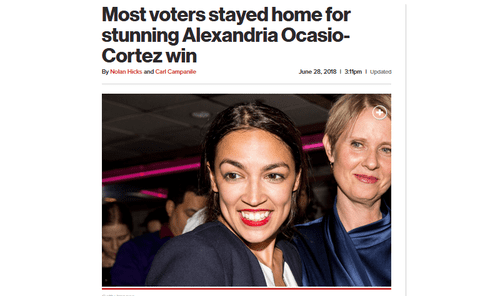
07/01/2018
Democrats on the far left have been doing cartwheels over the primary success of Alexandria Ocasio-Cortez against the powerful incumbent Joe Crowley last week. But it would be unwise for them to extrapolate to larger wins based on the rather extreme positions of political novice Ocasio, who identifies as a Democratic Socialist.
The demographics of New York’s 14th congressional district are helpful to Ocasio, being 49.8 percent Hispanic.
But more important was the tiny turnout, in part because New York is alone in splitting its state and federal primaries. Out of 214,750 active registered Democratic voters in the district, only 27,744 voted, just 13 percent of the total. With 98 percent of precincts counted, Ocasio-Cortez accrued 15,897 votes.
This is simply too small a sample of voters to base a refocus of a political party, but it shows how lost the Democrats are regarding their message. Ocasio is on the far edge of the fringe, favoring bilingual campaign posters and abolishing ICE.

Most voters stayed home for stunning Alexandria Ocasio-Cortez win, New York Post, June 28, 2018
Here’s what you get when you hold primary elections in June: A tiny percentage of party voters determine the congressional candidates.
Even in the most competitive races Tuesday, more than 80 percent of eligible voters stayed home.
In the race that caused an earthquake in the Democratic Party, 28-year-old newcomer Alexandria Ocasio-Cortez upset longtime Rep. Joe Crowley, 57 percent to 42 percent.
But only about 13 percent of registered Democrats turned out to vote in the 14th Congressional District that takes in parts of Queens and the Bronx, according to a preliminary city Board of Elections tally.
There are 214,750 active registered Democratic voters in the district. Only 27,744 voted, and Ocasio-Cortez won by more than 4,000 votes.
[ … ]
Voters generally turn out in much higher percentages in the general election than primaries.
But New Yorker powerbrokers make matters worse by holding two separate primaries — one for congressional races in June and another for state legislative races in September — preceding the general election in November.
“It’s voter burnout — not voter turnout,” [Steve] Romalewski said.
“The state Legislature could change the date of the primary to encourage higher turnout, but they don’t.”
The year’s results generally mirror the low turnout of prior years, Romalewski said.
This is a content archive of VDARE.com, which Letitia James forced off of the Internet using lawfare.